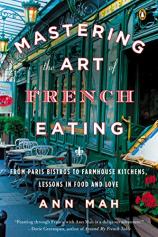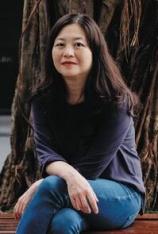Excerpt
Excerpt
Mastering the Art of French Eating: From Paris Bistros to Farmhouse Kitchens, Lessons in Food and Love

Introduction
Before we moved to Paris, in the summer of 2008, my husband, Calvin, and I used to pore over the atlas of France. I would stand in the kitchen cooking dinner, and he would lean on the counter, keep my wineglass filled, and turn the book’s wide pages. He’d read the names of regions out loud— Alsace, Bretagne, Champagne, Provence, Normandie— and we would dream about renting a car and circling the country, a road trip to the regions with the food we wanted to eat. Of course, this being France, that narrowed down the list to almost everywhere.
We talked about the road trip a lot as we runched toast on Sunday mornings. We listened to the Charles Trenet song “Route Nationale 7” and dreamed about the route des vacances, about the highway that makes a recipe. We read books set in hilltop Provençal villages and bourgeois Left Bank apartments. And yet I don’t think either one of us ever really thought we would take the trip. At the time we were living in New York, then Beijing, then Washington, D.C., moving every three years or so, blown hither and yon by Calvin’s job as a diplomat. “Maybe when we’re retired,” we said. “We’ll rent a car and drive everywhere in France. . . .” And so the fantasy began anew. But retirement was decades away.
In the fall of 2007, Paris couldn’t have been further from our minds. We had just moved to Washington, D.C., after four years in China. Calvin was traveling to Asia for work almost two weeks out of every month. And at thirty- two years old, I was struggling to ignite a career as a freelance food writer in a town whose favorite dish was power. But the wonderful, terrible thing about foreign-service life is that you move all the time. Our stint in Washington was for only a year, and by October, Calvin was already bidding on his next assignment. He put France on the list with lots of hope but very little expectation. Yet somehow, against all odds, we found out we were going to Paris.
In the months before the move, I could barely talk about it. I was petrified that any discussion, any expression of joy, any speculation about supermarchés or métro stops, would jinx everything. It just seemed too good to be true— a three- year sojourn in Paris with my favorite person, a chance to try the 246 varieties of cheese that de Gaulle had joked about, an opportunity to discover the cuisine of la belle France, to taste things that I had both read and dreamed about for half my life. And— the crowning flourish of shaved truffles—we would finally get to take the road trip. So I held my breath as we packed boxes, bought towels and sheets, and ticked off the days one by one. I held it throughout seven weeks of French immersion at a language school in rural Vermont. I held it as I stepped onto the plane in Washington and off it at Roissy, on the RER commuter rail, all the way to the Left Bank. And there, inside our new apartment, my mind dizzy with jet lag and happiness, I lay down on the bare parquet floor, stared up at the ornate crown molding, and sighed.
Perhaps I exhaled too soon. For we had scarcely unpacked our boxes and picked a favorite local boulangerie when Calvin got called away. To Baghdad. For a year. I stayed in Paris because Iraq was one of the few places in the world where we couldn’t be together. Instead of the shared adventure I had anticipated, I found myself navigating a new country, a new language, and a new culture alone while trying to keep the worry and loneliness at bay. Paris was still its elegant, gold- tipped, gleaming, curlicued self— as heartbreakingly lovely up close as when I’d dreamed about it from afar— but my dream of living there had changed.
At first I wasn’t sure how to maneuver myself toute seule. I missed my husband like an internal organ, and the city, which had seemed so quaintly formal when we were together— with its bonjours and bonsoirs, and four- course-dinner parties, and cheek kisses instead of hugs— felt a little cold now that I was alone. I wandered with trepidation, conscious of my American accent and Asian face and unsure grasp of French verbs. How could I find a place in this city that was so elegant and so uninviting? It felt like a herculean challenge, which I realized afresh every time I bought vegetables in the market and the vendeur corrected my French. (Me: Un botte de carottes, s’il vous plaît? Him: UNE botte. UNE! UNE!)
And then, somewhere in the midst of navigating new markets and memorizing new vocabulary, I remembered the wife of another American diplomat, a woman who had lived here sixty years earlier, another trailing spouse who needed a push to find her way: Julia Child.
Julia Child came to Paris because of the career of her husband, Paul Child. At first she was just another embassy spouse— albeit one who loved to eat— but when she started taking cooking classes at the Cordon Bleu, her path unfurled in a clear direction, one guided by food. Living in France and studying French cuisine changed her life. Food gave her a structure, a reason to ask questions, read history, explore, learn. It gave her a voice.
As I leafed through the butter- spattered pages of my copy of Mastering the Art of French Cooking, it occurred to me that the book could provide a basic itinerary for the road trip that Calvin and I had talked about for so many years. The recipes spanned the country—from Burgundy’s beef stew to Provence’s vegetable soup to the cassoulet of the southwest. But although each one offered practical head notes and precise instructions, I found myself wanting more information, itching for the story behind the dishes. Did people from Burgundy really eat boeuf bourguignon? Why was the wild and rocky coast of Brittany famous for buckwheat crêpes? How did pistou— which sounded an awful lot like “pesto”— end up in Provence?
And then there were the French dishes Julia and her coauthors hadn’t included. Was cheese fondue Swiss or French? Was choucroute garnie French or German? Was there a penchant in Troyes for tripe before the city started producing that most divisive of French sausages, andouillette? (And why was it always labeled AAAAA, as if it were trying to appear first in the phone book?)
The longer I lived in France, the more I ate. And the more I ate, the more questions I had. I yearned to discover French regional cuisine, and, I soon realized, the only way to truly understand it was to visit the regions themselves, to be curious, explore, taste, learn. In France dining is meant to be a special, pleasurable part of the day; food offers not only fuel for the body but also a connection—between the people who have joined you at the table, between the generations who have shared a recipe, between the terroir (the earth) and the culture and cuisine that have sprung from it. Separate from cooking, the very act of eating is in itself an art to master.
The story I tell here is of ten different regions of France and their signature dishes, of the link between history and place, culture and cuisine. I chose these ten dishes and regions because of their significance in the United States or, as is the case with Aveyron, because of its significance to me. But the list is not meant to be comprehensive—ten least- known dishes of French cuisine— and there are many regions and foods of France that I still look forward to discovering. This book is also the story of one American woman who was lucky enough to live in Paris for a while, of a solitary year mixed with loneliness and discovery, of creating a home when you move every few years, of building a life that balances work and personal ambition with love and family— and food.
“People who love to eat are always the best people,” said Julia Child. During my sojourn in France, I met many of these best people, and all of them— from chefs to charcutiers to home cooks to representatives of local offices du tourisme and so many others— touched me with their generosity and kindness, their infectious enthusiasm for their region. I hope this book honors their stories and work and recipes. For various reasons, I have compressed time in some instances, condensing the events of two years into one; I’ve also changed the names and identifying details of some friends and family; the names of the food professionals I interviewed, however, are all real.
I’ve always felt there are two states of existence: being in Paris and being out of it. This is the story of my time in the first state, before I returned to the second. The four years I spent in Paris felt like the shortest of my life, except for one— the year Calvin was in Baghdad— which was the longest. It changed me, of course, living in France— Julia Child could have told me that it would— even though, like a lot of big things, the change crept up on me little by little. Bite by bite. Which, I suppose, is the only way to savor life.
As they say in French, bonne continuation.
Mastering the Art of French Eating: From Paris Bistros to Farmhouse Kitchens, Lessons in Food and Love
- Genres: Food, Nonfiction, Travel
- paperback: 288 pages
- Publisher: Penguin Books
- ISBN-10: 0143125923
- ISBN-13: 9780143125921








